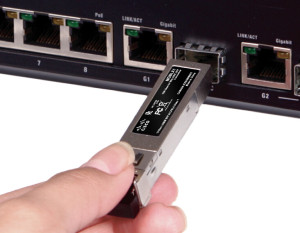 Do you know that there is a fiber tester inside your optical transceiver? This “fiber tester” we call it DOM, which is short for Digital Optical Monitoring. DOM is a feature that enables the monitoring of some interesting status values on the interface with the most useful values being the optical receive and transmits powers. You can configure your Cisco or other brands’ device to monitor optical transceivers in the system, either globally or by specified ports. When this feature is enabled, the system will monitor the temperature and signal power levels for the optical transceivers. CONSOLE messages and SYSLOG messages are sent when optical operating conditions fall below or rise above the optical transceiver manufacturer’s recommended thresholds. By being able to monitor transmit and receive power levels of optical interfaces, you can characterize the fiber loss and isolate any unidirectional connectivity issues. So, how to use Cisco DOM for your optical transceiver in Cisco system is the main topic today.
Do you know that there is a fiber tester inside your optical transceiver? This “fiber tester” we call it DOM, which is short for Digital Optical Monitoring. DOM is a feature that enables the monitoring of some interesting status values on the interface with the most useful values being the optical receive and transmits powers. You can configure your Cisco or other brands’ device to monitor optical transceivers in the system, either globally or by specified ports. When this feature is enabled, the system will monitor the temperature and signal power levels for the optical transceivers. CONSOLE messages and SYSLOG messages are sent when optical operating conditions fall below or rise above the optical transceiver manufacturer’s recommended thresholds. By being able to monitor transmit and receive power levels of optical interfaces, you can characterize the fiber loss and isolate any unidirectional connectivity issues. So, how to use Cisco DOM for your optical transceiver in Cisco system is the main topic today.
What Parameters Are Monitored by Cisco DOM?
DOM allows monitoring of some parameters. So those network administrators can then check and ensure that the module is functioning correctly. These real-time operating parameters include:
- Optical Tx power
- Optical Rx power
- Laser bias current
- Temperature
- Transceiver supply voltage
How to Use Cisco DOM?
There are some restrictions of using DOM in Cisco system including:
- Ensure that your optical transceiver supports DOM. For Cisco original optical transceivers, you need the transceiver module compatibility information for configuring transceiver monitoring. (See Compatibility Matrix)
- In case of combo ports with SFP and RJ45 provision, SFP is inserted in slot or port and media type is not configured to SFP, DOM is functional only if global transceiver monitoring is enabled.
- CISCO-ENTITY-SENSOR-MIB traps are sent only once after the threshold violation. However, SYSLOG traps are sent based on the monitoring interval.
| Command or Action | Purpose | |
| Step 1 | enableExample: Router> enable | Enables the privileged EXEC mode.• Enter your password if prompted. |
| Step 2 | configure terminalExample: Router# configure terminal | Enters the global configuration mode. |
| Step 3 | transceiver type allExample: Router(config)# transceiver type all | Enters the transceiver type configuration mode. |
| Step 4 | monitoringExample: Router(config-xcvr-type)# monitoring | Enables monitoring of all optical transceivers. |
| Step 5 | monitoring intervalExample: Router(config-xcvr-type)# monitoring interval 500 | (Optional) Specifies the time interval for monitoring optical transceivers. Valid range is 300 to 3600 seconds, and the default value is 600 seconds. |
In conclusion, there are three main commands that can be used to turn on/off DOM for all transceivers type in the system:
- Router(config)#transceiver type all
- Router(config-xcvr-type)#monitoring
- Router(config-xcvr-type)#end
Once enabled, DOM can be accessed via CLI using “show interface transceiver command“, shown as the following picture:

DOM is incredibly handy when troubleshooting fiber issues. A low value in the Rx Power column indicates that you have a bad fiber, or more commonly, a dirty fiber optic patch cable somewhere.
Of all the five values, the two most used and relevant values are TX and RX power, and the temperature is also used sometimes. The operating range of these three values is unique across all modules and is available in the datasheet. Additionally, there is an extension available for this command, which is also very helpful and is used to check threshold values of the above parameters like temperature, Tx and Rx. The command is “show interface gig x/y transceiver detail“.
How about Non-Cisco Transceiver with DOM
Though Cisco DOM is a very helpful functionality of optical transceiver, not all transceivers support DOM in Cisco’s optical transceiver products family. For example, the common SFPs, such as the GLC-LX or GLC-SX units that are used by most network engineers on a day to day basis are not with DOM feature. Why not add this helpful and convenient feature to all transceivers? Actually, Cisco has their own attitude. They think that DOM functionality is worth an extra $300 a pop, putting the cost of a DOM-enabled single mode SFP close to $800. However, DOM functionality is not a novel thing now. Surprisingly, there are some third-party optical transceivers, including the DOM functionality but at a low cost. Fiberstore, for instance, as the professional optical transceiver manufacturer and supplier, they can offer Cisco compatible GLC-LX-SM-RGD with DDM or DOM functionality just at $18.00. But if we want to use non-Cisco transceivers, we need a little different approach to get started with DOM of non-Cisco transceivers. To enable support for non-Cisco SFPs, command “Router(config)#service unsupported-transceiver” is necessary.
For more information about optical transceiver with DOM, please visit Fiberstore.
Related Article: About DDM, DOM and RGD in SFP Transceiver Module
Related Article: What Is An Optical Module?





